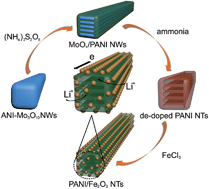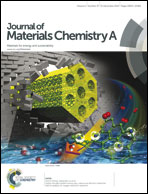Aqueous Li-ion cells with superior cycling performance using multi-channeled polyaniline/Fe2O3 nanotube anodes†
Abstract
We developed a Fe2O3-decorated polyaniline (PANI/Fe2O3) multi-channeled nanotube structure as aqueous rechargeable lithium-ion battery (ARLIB) anode using polymerized aniline–Mo3O10 (ANI–Mo3O10) nanowires as the template. The removal of MoOx from the intercalated layered MoOx/PANI structures results in a multi-channeled nanotube structure, and the subsequent hydrothermal growth of Fe2O3 nanoparticles on PANI surface can simultaneously re-dope PANI into a highly conductive form. The multi-channeled nanotube structure allows for sufficient electrolyte impregnation and efficient one-dimensional electron transport, and the decorated Fe2O3 surface layer offers a much extended voltage window of the electrode and improves chemical and electrochemical stability. As a proof-of-concept, the initial discharge and charge capacities of the PANI/Fe2O3 multi-channeled nanotube anode are 60.5 and 54.2 mA h g−1 at a current rate of 150 mA g−1, respectively. When fabricated as an ARLIB full cell with the PANI/Fe2O3 multi-channeled nanotube anode and a LiMn2O4 cathode, an initial discharge capacity of 50.5 mA h g−1 is obtained at the current rate of 150 mA g−1, with superior capacity retention of 73.3% after over 1000 charge/discharge cycles.


 Please wait while we load your content...
Please wait while we load your content...